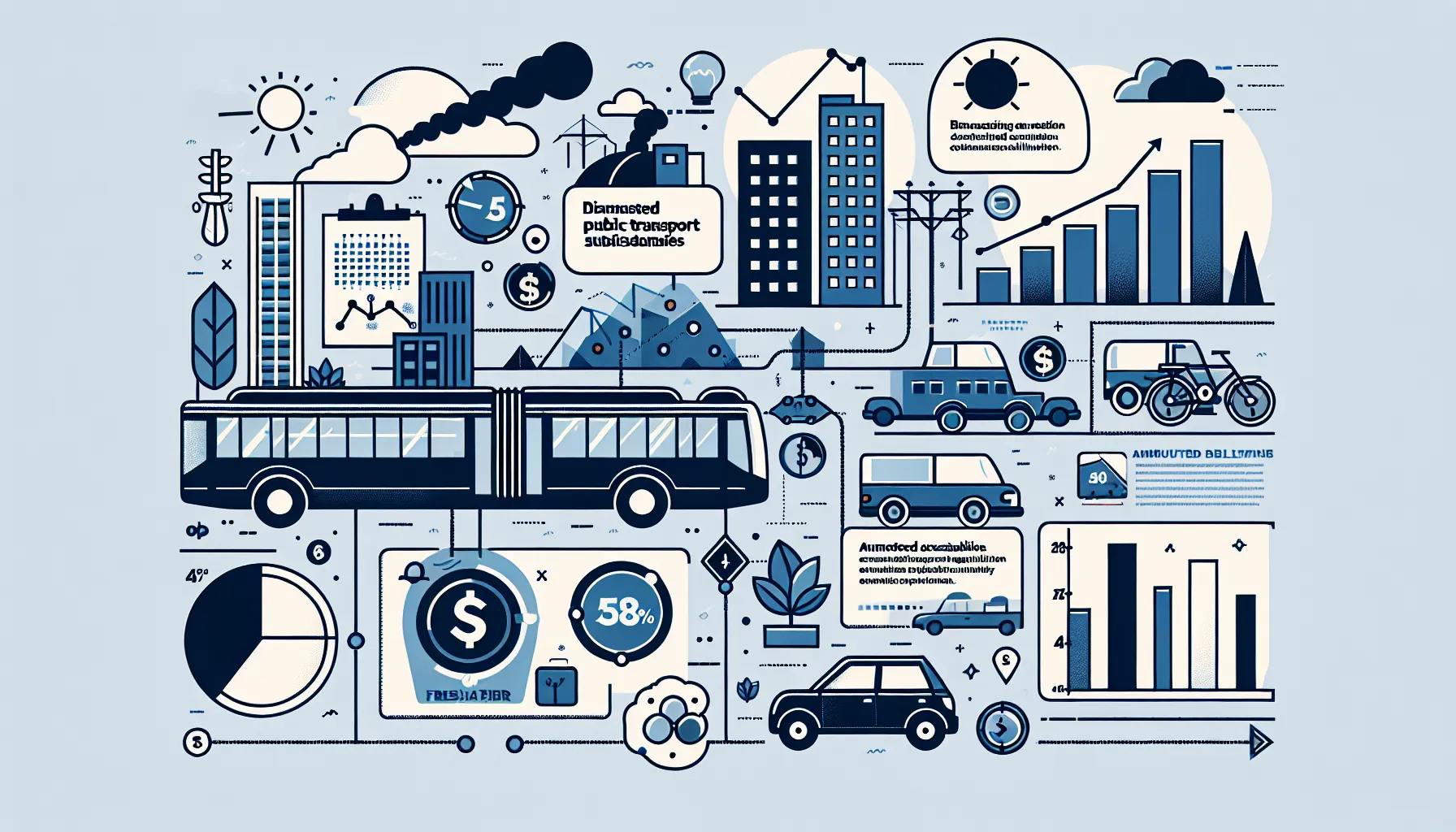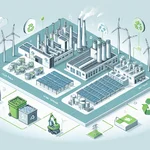Public transport subsidies have become an increasingly popular topic in IELTS Writing Task 2 essays. This subject often appears in various forms, addressing issues related to government funding, urban planning, and environmental concerns. Based on past exam trends and current global discussions, we can expect this theme to remain relevant in future IELTS tests. Let’s explore a specific question on this topic and analyze sample essays for different band scores.
Some people think that governments should subsidize public transportation to reduce traffic congestion and air pollution. Others believe that there are better ways to address these issues. Discuss both views and give your own opinion.
Analyzing the Question
This question requires candidates to:
- Discuss the view that governments should subsidize public transport
- Explore alternative solutions to traffic congestion and air pollution
- Provide their personal opinion on the matter
It’s crucial to address all parts of the question to achieve a high band score.
Sample Essay 1: Band 8-9
Public transportation plays a vital role in modern urban life, and the debate over government subsidies for this sector is ongoing. While some argue that subsidizing public transport is an effective way to combat traffic congestion and air pollution, others contend that alternative solutions might be more beneficial. In my opinion, a combination of subsidized public transport and other measures is the most effective approach to addressing these urban challenges.
Those in favor of government subsidies for public transportation argue that it can significantly reduce the number of private vehicles on the roads. By making buses, trains, and metros more affordable and accessible, more people are likely to opt for these services over personal cars. This shift could lead to a substantial decrease in traffic congestion, especially during peak hours. Moreover, fewer vehicles on the roads translate to reduced emissions, thereby improving air quality in urban areas. Cities like Vienna and Tallinn, which have implemented heavily subsidized or free public transport, have seen positive results in terms of ridership and reduced car usage.
On the other hand, critics of this approach argue that there are more effective ways to tackle traffic and pollution issues. They suggest that investing in smart traffic management systems, promoting bicycle infrastructure, or implementing congestion pricing in city centers could yield better results. For instance, London’s congestion charge has been successful in reducing traffic and improving air quality in the city center. Additionally, some argue that subsidies can lead to inefficiencies in the transport system and place a significant burden on government budgets.
In my view, a multifaceted approach that includes subsidized public transport alongside other measures is the most effective solution. While subsidies can make public transport more attractive and accessible, they should be complemented by investments in sustainable infrastructure, urban planning reforms, and technological innovations. For example, combining subsidized public transport with extensive bike-sharing programs and pedestrian-friendly urban design can create a more comprehensive and effective transportation ecosystem.
In conclusion, while subsidizing public transport can be a powerful tool in combating traffic congestion and air pollution, it should not be seen as a standalone solution. A holistic strategy that incorporates various approaches, including subsidies, smart city planning, and technological advancements, is likely to yield the best results in creating efficient, sustainable urban transportation systems.
(Word count: 365)
 Public transport subsidies concept
Public transport subsidies concept
Sample Essay 2: Band 6-7
In recent years, the idea of governments subsidizing public transportation has gained attention as a potential solution to traffic congestion and air pollution. While some people believe this is an effective approach, others think there are better ways to address these issues. This essay will discuss both viewpoints and provide my opinion on the matter.
Supporters of public transport subsidies argue that it can help reduce the number of cars on the roads. If buses and trains are cheaper and more convenient, more people might choose to use them instead of driving their own cars. This could lead to less traffic on the streets and fewer emissions from vehicles, which would improve air quality in cities. For example, some cities that have made public transport free or very cheap have seen more people using these services.
However, others believe there are more effective solutions to these problems. They suggest that investing in better road infrastructure, encouraging carpooling, or promoting work-from-home policies could be more beneficial. These alternatives might be less expensive for governments and could have a more immediate impact on reducing traffic and pollution. Additionally, some argue that subsidizing public transport might not be fair to those who live in areas with limited access to these services.
In my opinion, a combination of approaches is necessary to effectively address traffic congestion and air pollution. While subsidizing public transport can be helpful, it should be part of a larger plan that includes improving infrastructure, promoting alternative transportation methods like cycling, and implementing smart traffic management systems. This comprehensive approach is more likely to produce significant and lasting results.
To conclude, while subsidizing public transport can contribute to reducing traffic and pollution, it is not the only solution. A balanced approach that combines various strategies is likely to be more effective in creating sustainable and efficient urban transportation systems.
(Word count: 309)
Sample Essay 3: Band 5-6
Many people think that governments should give money to make public transport cheaper. They say this can help with traffic problems and pollution. But some people think there are better ways to solve these issues. I will talk about both ideas and give my opinion.
People who support cheaper public transport say it can help reduce cars on the roads. If buses and trains are less expensive, more people might use them instead of driving. This could mean less traffic in cities and less pollution from cars. Some cities have tried making public transport very cheap or free, and more people started using it.
But other people think there are better solutions. They say governments could build better roads, encourage people to share cars, or let more people work from home. These ideas might cost less money and could help fix the problems faster. Also, some people think it’s not fair to make public transport cheaper if not everyone can use it easily.
I think we need to use many different ideas to fix traffic and pollution problems. Making public transport cheaper can help, but we should also do other things. We should make better roads, help people use bicycles, and use technology to control traffic better. If we do all these things together, it will probably work better.
In conclusion, while cheaper public transport can help with traffic and pollution, it’s not the only answer. We need to use many different ideas together to make city transport better and cleaner.
(Word count: 253)
Explaining the Band Scores
Band 8-9 Essay:
- Task Response: Fully addresses all parts of the task with a well-developed response.
- Coherence and Cohesion: Ideas are logically organized with clear progression throughout.
- Lexical Resource: Wide range of vocabulary used with flexibility and precision.
- Grammatical Range and Accuracy: Wide range of structures with full flexibility and accuracy.
Band 6-7 Essay:
- Task Response: Addresses all parts of the task, though some aspects are more fully covered than others.
- Coherence and Cohesion: Information and ideas are generally well organized with clear overall progression.
- Lexical Resource: Sufficient range of vocabulary for the task, with some less common words used.
- Grammatical Range and Accuracy: Mix of simple and complex sentence forms with generally good control.
Band 5-6 Essay:
- Task Response: Addresses the task only partially, with limited development of ideas.
- Coherence and Cohesion: Basic organization is apparent, but not always logical.
- Lexical Resource: Limited range of vocabulary, but adequate for basic communication.
- Grammatical Range and Accuracy: Limited range of structures with some errors that may impede communication.
Key Vocabulary to Remember
- Subsidize (verb) /ˈsʌbsɪdaɪz/ – to support financially
- Congestion (noun) /kənˈdʒestʃən/ – overcrowding, especially of traffic
- Infrastructure (noun) /ˈɪnfrəstrʌktʃə(r)/ – basic physical systems of a country or region
- Emissions (noun) /ɪˈmɪʃn/ – the production and discharge of something, especially gas or radiation
- Sustainable (adjective) /səˈsteɪnəbl/ – able to be maintained at a certain rate or level
- Multifaceted (adjective) /ˌmʌltɪˈfæsɪtɪd/ – having many different aspects or features
- Ecosystem (noun) /ˈiːkəʊˌsɪstəm/ – a complex network or interconnected system
- Holistic (adjective) /həˈlɪstɪk/ – characterized by the belief that the parts of something are interconnected
- Ridership (noun) /ˈraɪdərʃɪp/ – the number of passengers using a particular form of public transport
- Inefficiencies (noun) /ˌɪnɪˈfɪʃnsiz/ – lack of efficiency or effectiveness
In conclusion, the topic of public transport subsidies is likely to remain relevant in IELTS Writing Task 2. To prepare effectively, practice writing essays on related themes such as urban planning, environmental protection, and government spending on infrastructure. Remember to always address all parts of the question, use a range of vocabulary and sentence structures, and organize your ideas coherently. Feel free to share your practice essays in the comments section for feedback and further improvement!


